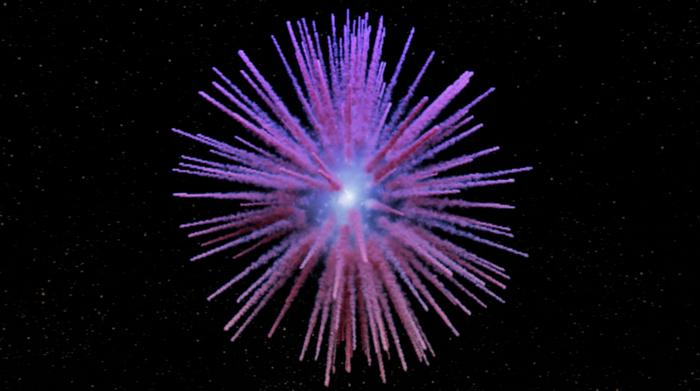Reviewed by Lexie CornerOct 25 2024
In 1181, a supernova near Cassiopeia shone brightly for six months. Recent observations using Caltech’s Keck Cosmic Web Imager (KCWI) have provided an unprecedented 3D view, revealing high-speed, dandelion-like filaments that expand ballistically, tracing the explosion precisely back to its origin.
 An artist’s concept of a supernova remnant called Pa 30—the leftover remains of a supernova explosion that was witnessed from Earth in the year 1181. Unusual filaments of sulfur protrude beyond a dusty shell of ejected material. The remains of the original star that exploded, now a hot inflated star that may cool to become a white dwarf, are seen at the center of the remnant. The Keck Cosmic Web Imager (KCWI) at the W.M. Keck Observatory in Hawai‘i has mapped the strange filaments in 3-D and shown that they are flying outward at approximately 1,000 km per second. Image Credit: W.M. Keck Observatory/Adam Makarenko
An artist’s concept of a supernova remnant called Pa 30—the leftover remains of a supernova explosion that was witnessed from Earth in the year 1181. Unusual filaments of sulfur protrude beyond a dusty shell of ejected material. The remains of the original star that exploded, now a hot inflated star that may cool to become a white dwarf, are seen at the center of the remnant. The Keck Cosmic Web Imager (KCWI) at the W.M. Keck Observatory in Hawai‘i has mapped the strange filaments in 3-D and shown that they are flying outward at approximately 1,000 km per second. Image Credit: W.M. Keck Observatory/Adam Makarenko
Astronomers have been puzzled by this phenomenon for decades. It was first recorded nearly a thousand years ago as a “guest star” by Chinese and Japanese observers. It is one of the few supernovae documented before telescopes were invented.
Moreover, it remained the longest-standing “orphan” supernova, meaning that, until recently, none of the currently visible celestial objects could be attributed to it. Only in 2021 was its remnant—now identified as supernova SN 1181—linked to the nebula Pa 30, discovered in 2013 by amateur astronomer Dana Patchick through a citizen science project using the WISE telescope image archive.
This nebula, however, is no ordinary supernova remnant. At its core lies a surviving “zombie star”—a remnant within a remnant—that has captivated astronomers. It’s believed that SN 1181 was triggered by a thermonuclear explosion on a white dwarf, a dense, dead star.
Typically, such an explosion would destroy the white dwarf entirely, but in this case, part of the star survived, creating what’s known as a “zombie star.” This type of partial explosion, known as a Type Iax supernova, produced unusual filaments that resemble the petals of a dandelion.
These peculiar filaments have now been observed in unprecedented detail by ISTA Assistant Professor Ilaria Caiazzo and lead author Tim Cunningham, a NASA Hubble Fellow at the Center for Astrophysics, Harvard & Smithsonian.
A 3D Model of a Ballistically Expanding Explosion
Caltech's Keck Cosmic Web Imager (KCWI) enabled the team led by Cunningham and Caiazzo to conduct a detailed analysis of this unusual supernova remnant. The KCWI spectrograph, located at the W. M. Keck Observatory in Hawaii, sits above 4,000 m near the summit of Mauna Kea, the highest point in the state.
As its name suggests, KCWI was initially designed to study the “cosmic web”—a term for some of the universe's faintest and darkest light sources. Its high sensitivity and innovative design enable KCWI to capture spectral information for every pixel in an image.
KCWI can also generate a 3D “movie” of a supernova by measuring the velocity of matter in a stellar explosion. It does this by observing how light shifts as it moves toward or away from us, similar to the well-known Doppler shift, which changes the tone of an ambulance siren as it speeds by.
This capability allowed the researchers to create a detailed 3D map of the nebula and its unusual filaments, going beyond the typical static images of supernovae. They demonstrated that the material in the filaments moved ballistically at roughly 1,000 km/s.
This means that the ejected material has not been slowed down, or sped up, since the explosion. Thus, from the measured velocities, looking back in time allowed us to pinpoint the explosion to almost exactly the year 1181.
Tim Cunningham, Lead Author and NASA Hubble Fellow, Center for Astrophysics, Institute of Science and Technology Austria
Evidence of an Unusual Asymmetry
The supernova's general shape is particularly remarkable, with dandelion-shaped filaments expanding ballistically. The group demonstrated that the material within these filaments, known as ejecta, is being blasted away from the explosion site in an unusually asymmetrical pattern.
This asymmetry suggests that the explosion itself is the source. Additionally, the filaments appear to have a sharp inner edge, creating an inner “gap” around the zombie star.
Our first detailed 3D characterization of the velocity and spatial structure of a supernova remnant tells us a lot about a unique cosmic event that our ancestors observed centuries ago. But it also raises new questions and sets new challenges for astronomers to tackle next.
Ilaria Caiazzo, Assistant Professor, Institute of Science and Technology Austria
She began this research effort at Caltech, USA, as a Burke-Sherman Fairchild Postdoctoral Fellow in theoretical astrophysics before joining ISTA in May this year.
Journal Reference:
Cunningham, T., et al. (2024) Expansion Properties of the Young Supernova Type Iax Remnant Pa 30 Revealed. The Astrophysical Journal Letters. doi.org/10.3847/2041-8213/ad713b.